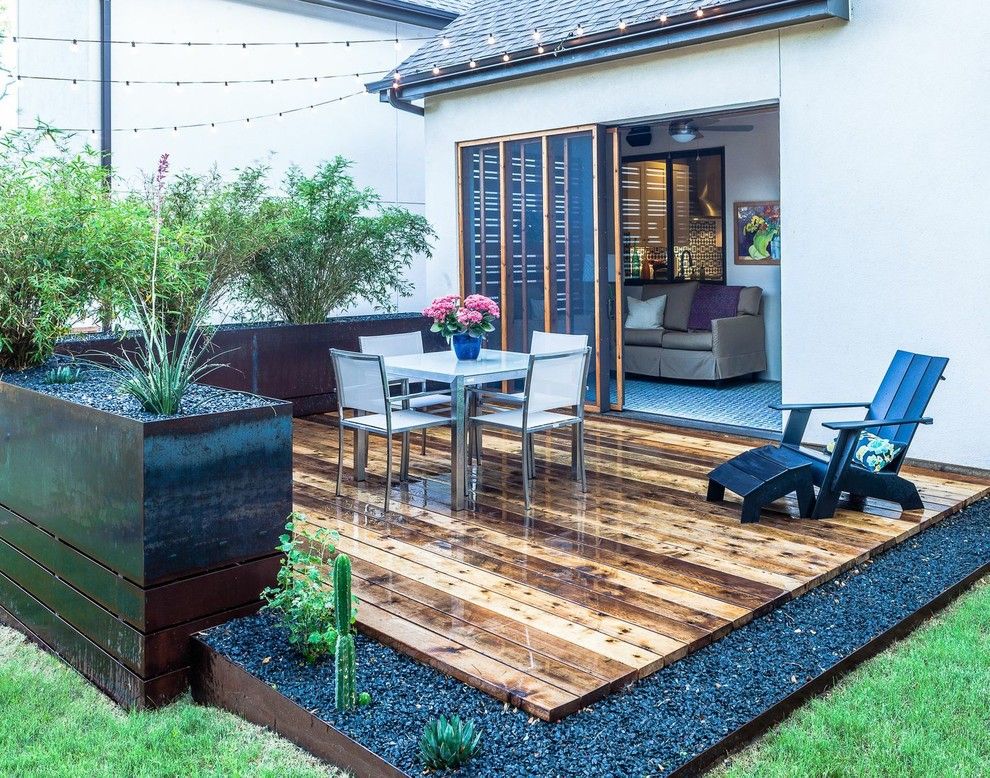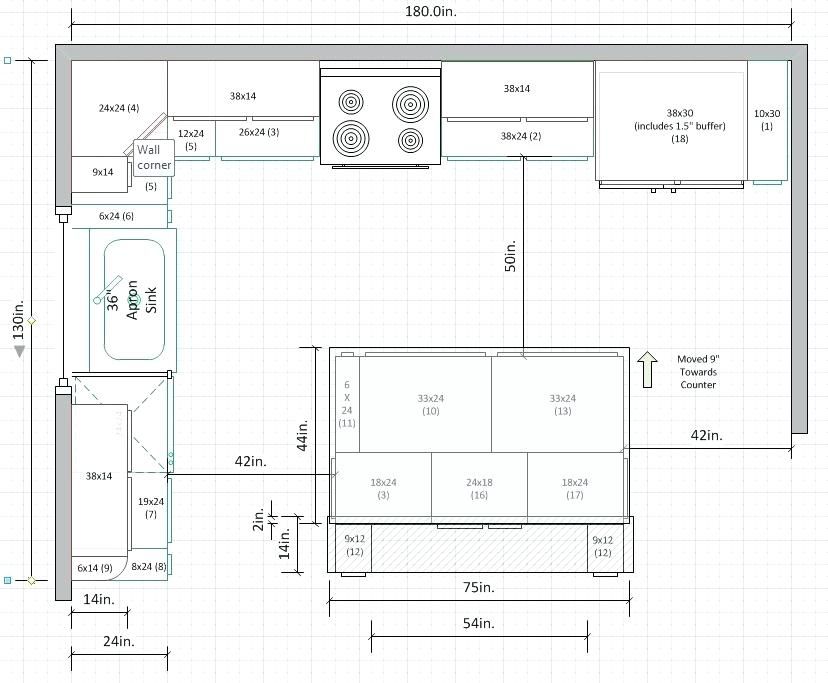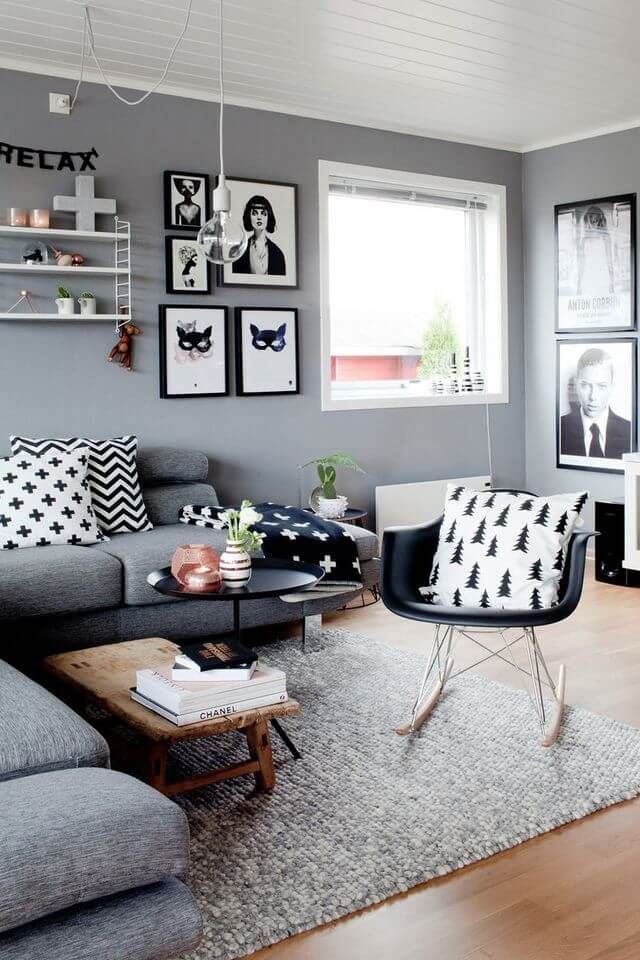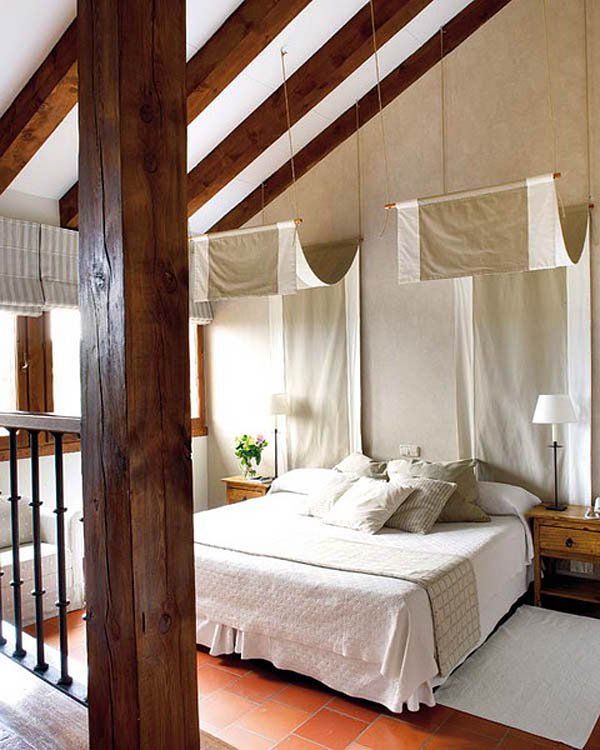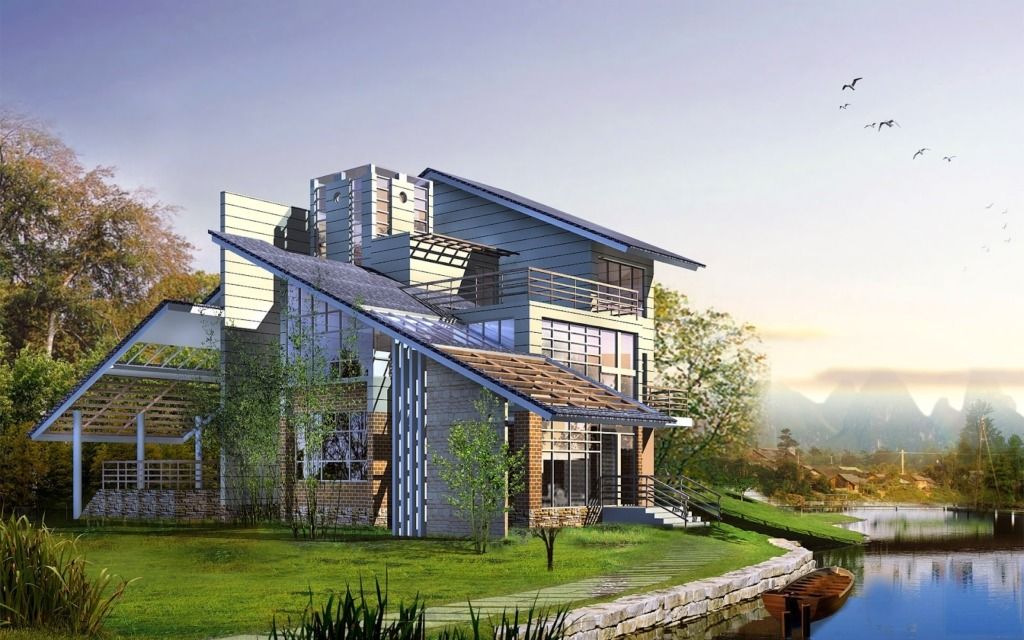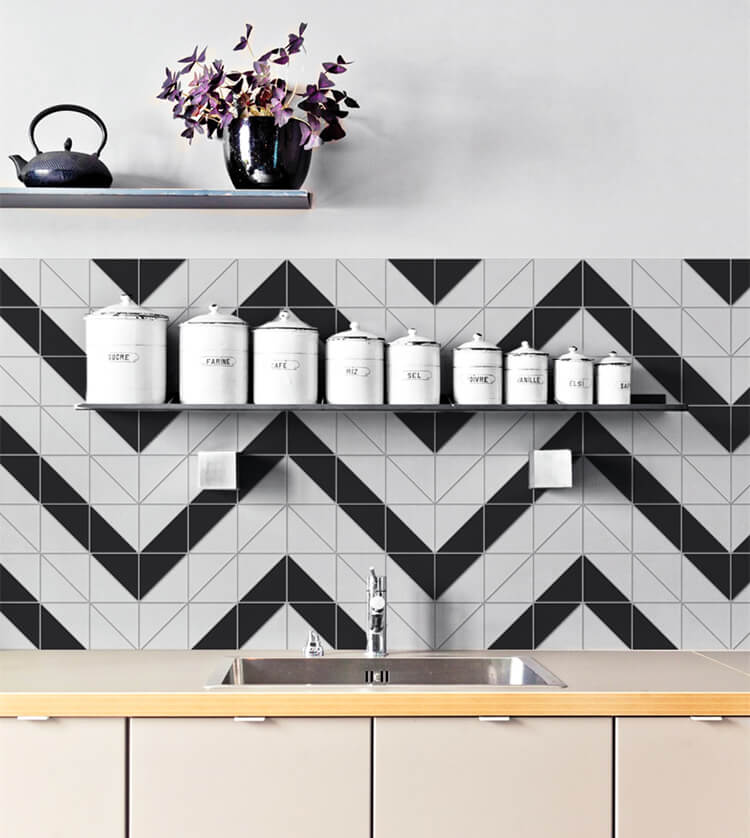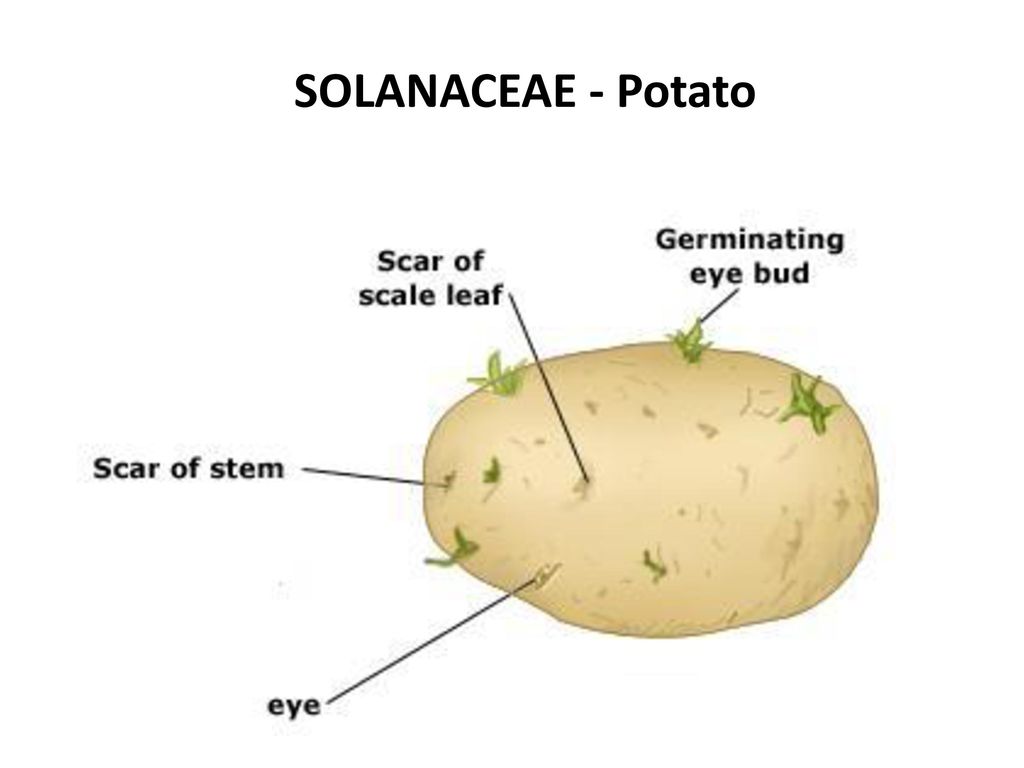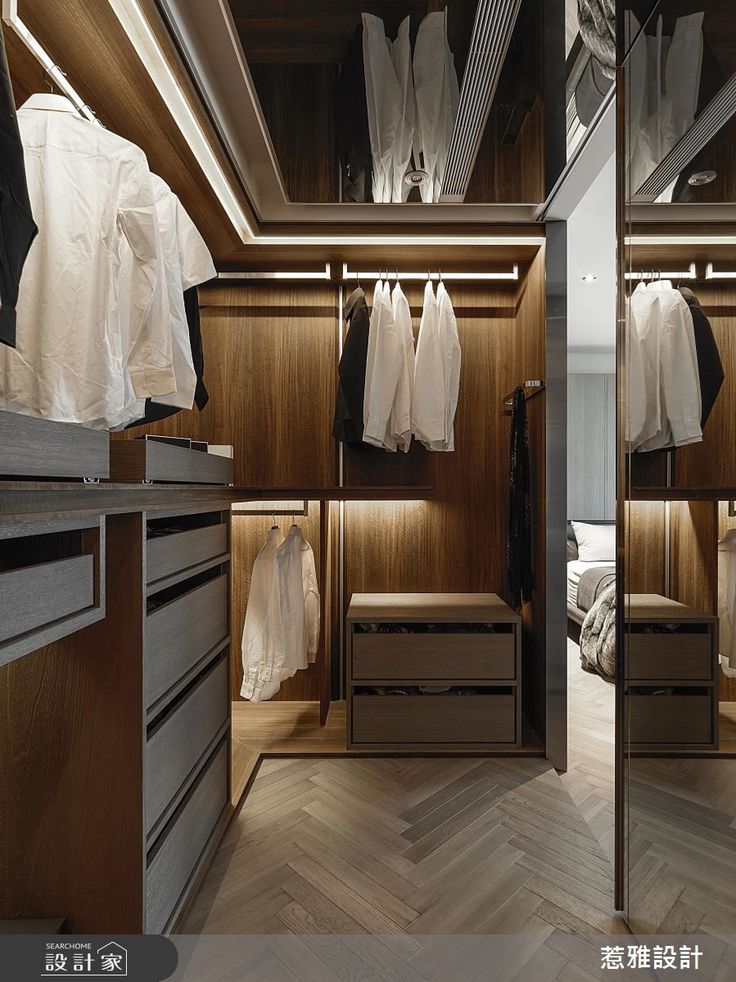Garden decking colours
how to choose the color to paint your deck |
(Image credit: Simon Orchard Garden Design)
Deck color ideas might be on your list of decisions to make if you are transforming your backyard. A deck, after all, can be the design's focal point, so to exploit its potential to the maximum, it’s worth considering which color is the best option for you.
Or, perhaps you are improving your existing deck and looking for deck ideas? Its original shade may have deteriorated over time and a deck color revamp may be due. Simply staining or painting your deck a new color might be all you need to transform your outdoor space.
'You can match a deck to a warm, rich hard and soft landscaping palette, or tone a silvered deck with a planting scheme,’ says Catherine MacDonald, Principal Landscape designer at Landform Consultants . ‘If the decking is adjacent to the house, tonally matching the interior floor color with the decking color can help create a sense of space and bring the outside in. ’
Deck color ideas
To get you started, we’ve put together the best deck color ideas to make yours a handsome part of your outdoor landscape.
1. Take a cue from indoors
(Image credit: TimberTech)
'Homeowners are starting to think about the outdoor living space as an extension of their home – bringing trends from the indoors, like multi-width boards and lighter flooring, to the outdoor space,' says Sam Toole CMO at The AZEK Company , a flooring company that produces decking.
Especially if your deck connects directly to your living space, consider continuing the color of your indoor flooring out onto your deck.
2. Let the natural beauty shine through
(Image credit: Sam Wadieh)
If your budget for your deck costs allows for a high quality, real-wood decking like cedar, there may be no need to paint or stain it at all. Instead, choose a clear, oil-based wood sealer that will make your decking waterproof without loosing the beauty of the natural wood tone.
This California yard by landscape designer Sarita Jaccard plays up the home's desert-midcentury vibe, and proves that sometimes, natural wood tones makes the best color choice. To settle on the amber colored decking above, Jaccard looked for a material that would offset the deep-gray gravel in the yard.
3. Go for a deep espresso
(Image credit: TimberTech)
A dark wood stain straddles the line between traditional and contemporary styles, making it a good choice for those who love a transitional decorating scheme, or are looking to give an older outdoor area an updated feel. Darker wood tones, like the espresso-colored decking above, also feel more sophisticated than paler-toned options.
4. Encourage weathered decking
(Image credit: Future / David Giles )
While staining and sealing your deck can increase its longevity, you don't technically have to seal your deck to keep it good shape. If you prefer your deck to take on a weathered look or a silvery hue (think wooden Adirondack chairs that get left out year-round or an old dock in the water), then you can simply leave the wood untreated and let nature take it's course.
This type of weathered, rough hewn decking is a lovely match for cottage garden ideas or coastal properties.
5. Go for a modern look
(Image credit: Brittany Farinas, House of One / Lifestyle Production Group)
If you live in a contemporary home, be sure to choose a deck color idea that suit the style of the architecture, as well as more modern deck railing ideas. Generally, that means choosing a deck color with gray undertones, like the deck above, or one that's either very pale, or very dark. In between colors like oaks, red wood tones, or medium-browns won't complement a modern home as well.
(Image credit: Little Greene)
If you want to put the focus on the most colorful elements of a garden – which might be an array of flowers or a permanent feature like this blue-painted wall, or both – opt for a subtle gray color for the deck.
Make sure you use exterior masonry paint for a garden wall like this one, and opt for blooms on the blue and violet parts of the color wheel if you pick a similar shade in order to create a harmonious effect.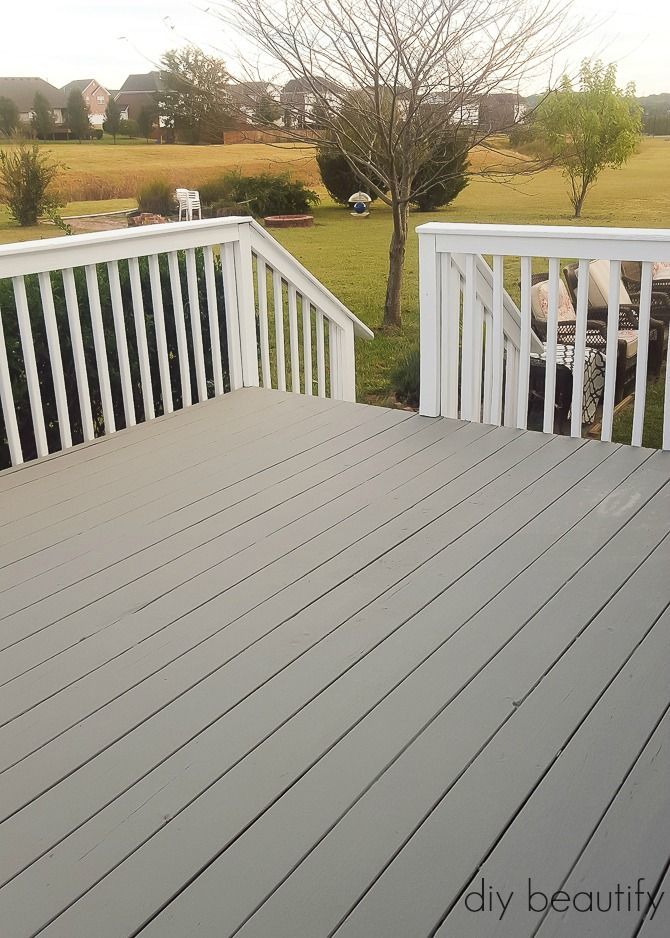
7. Keep deck shades soft
(Image credit: Arterra Landscape Architects)
This courtyard garden in San Francisco by Arterra Landscape Architects features a deck for relaxing on that extends into a path leading down the narrow space. ‘We used cedar and let it naturally gray out for low maintenance,’ says partner Gretchen Whittier.
Some decking woods can take years to gray, so if you want the same gentle colorway to complement a planting scheme, painting the deck is a speedy shortcut to the same look.
8. Create a continuous effect
(Image credit: Ronseal)
If your deck is surrounded by fencing or deck planting, choose a color you can use to paint both it and the fence for an area that really does say ‘outdoor room’.
Select a shade that will reflect the light and recede from the eye for painting what are the walls and the floor of an exterior room to keep it bright and open. They’ll also reflect candlelight for a deck that’s atmospheric after dusk.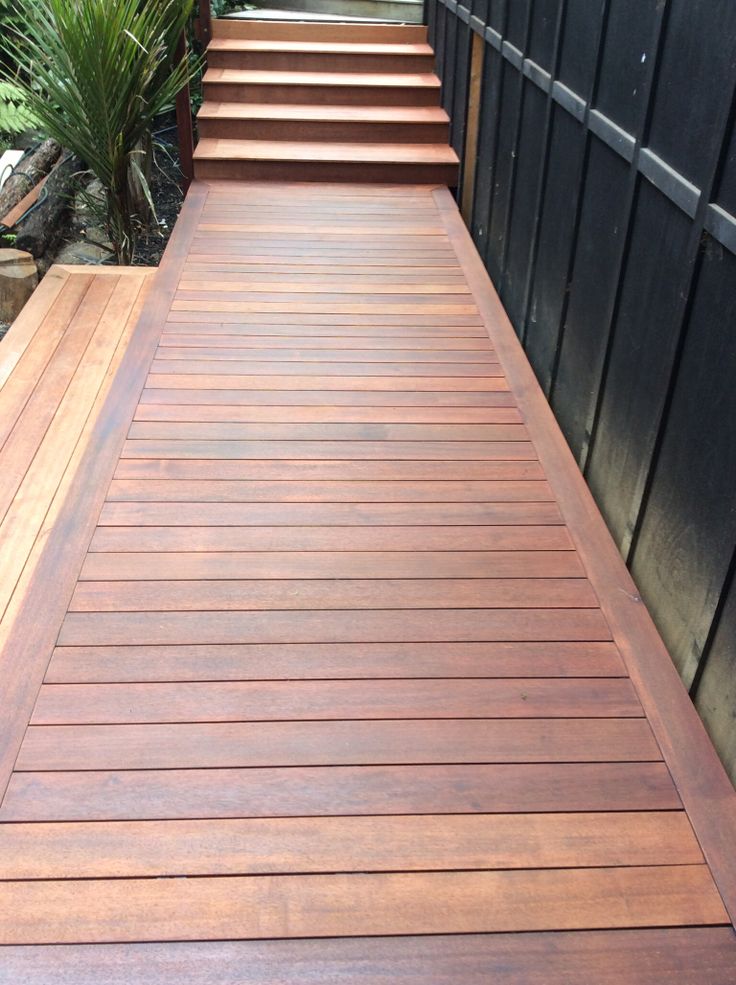
This trick is particularly useful at enhancing space – perfect if you are looking for small garden decking ideas.
9. Take your cue from nature
(Image credit: Future / Mark Bolton)
In this backyard, the deck has been designed around the beautiful trees that bring shade at the water’s edge, and the dark deck color echoes the shade of the bark. It’s a strategy that harmonizes the natural and the built parts of the garden so they look as if they’re meant to be together.
You’ll want to choose a deck paint that promises to be slip resistant to renovate or transform a deck in any case, but it’s a particularly important attribute for a deck beside a pool.
10. Team with pavers
(Image credit: Kate Eyre Garden Design)
Decking may be just one of the hard surfaces underfoot within a garden scheme, and choosing the right deck color can ensure each works happily alongside the other. In this London garden by Kate Eyre Garden Design the curvilinear design which makes the long thin garden feel wider features porcelain pavers and pebbled areas, too.
‘I love the neutral tones in a garden as it feels more natural whilst still looking chic,’ says Kate. ‘Personally in our design team, we love the contrast of the porcelain against the decking in terms of textures and color.’
11. Match outdoors with in
(Image credit: Future / Anna Stathaki)
For a deck beyond sliding or bi-fold doors that can open the interior right up to the backyard whenever the weather is good enough, try a deck paint that matches the color of interior flooring. It will make the two different surfaces appear as one, blurring the division between indoors and out for space-stretching effect.
Laying interior floor boards and exterior deck boards in the same orientation if you’re putting them in new is also a tactic worth adopting to further blur the distinction between the two areas.
12. Make planting pop with a dark deck colors
(Image credit: Future / Paul Whicheloe)
Just like inside your home, a dark backdrop can make the accent shades you choose for a garden scheme pop.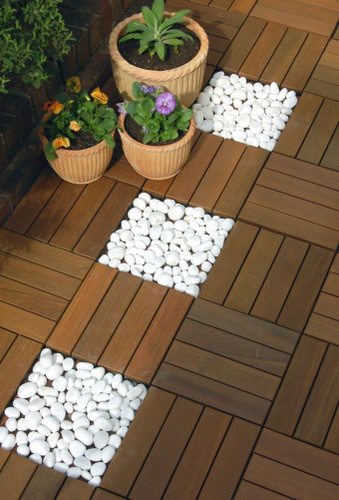 Inside, it’s walls you’d paint to achieve this effect, but outside, paint the deck in a slate, charcoal, or deep color tone to set off lounger upholstery, floor cushions, or contemporary furniture in brilliant shades.
Inside, it’s walls you’d paint to achieve this effect, but outside, paint the deck in a slate, charcoal, or deep color tone to set off lounger upholstery, floor cushions, or contemporary furniture in brilliant shades.
Combined with an outdoor kitchen in gray, this dark statement deck has fabulous modern credentials.
13. Contrast the deck color with the house
(Image credit: Future / Adam Wallis)
Consider deck paint that will contrast with the exterior of your home – particularly for a small deck. It will help define the exterior seating area. Black and white is a classic combination, but you could get a similar look with any dark and light pairing. Follow the lead of this home with furniture that continues the home’s color and containers that repeat that of the deck boards to pull the look together.
14. Tone with pebbled areas
(Image credit: Future / Douglas Gibb)
If your deck boards or squares are laid next to pebbles or gravel, opt for deck paint color in a tonal shade.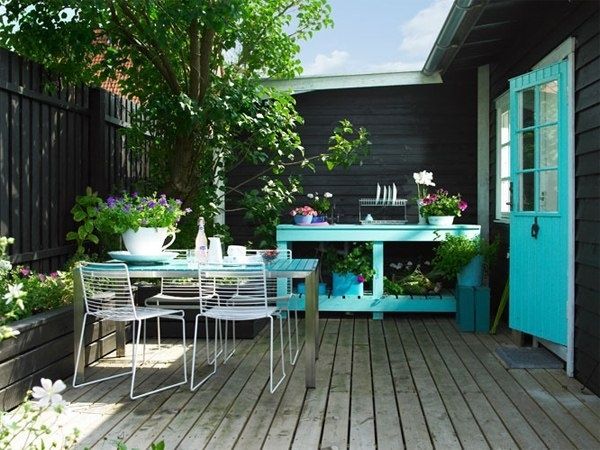 The different textures of the materials will provide plenty of interest underfoot, so you needn’t be concerned that the effect will be bland.
The different textures of the materials will provide plenty of interest underfoot, so you needn’t be concerned that the effect will be bland.
In this garden deck boards, deck squares and pebbles in bleached tones are a soft contrast to the vibrant green of foliage plants grown amongst them.
15. Harmonize decking with furniture colors
(Image credit: John Lewis)
You could take a similar tack as above, but painting the deck to co-ordinate its color with garden furniture or deck railing ideas instead. Here, the palette is neutral for a calming ambience with pale wood furniture plus a light finish for the deck.
Woven dining chairs provide textural contrast to the smoother timber of the dining set and deck, so the monochromatic scheme isn’t flat. Follow this design’s lead by finishing a dining or seating area with cushions in linen and a faux fur throw to boost the tactility of the space.
16. Repeat a door color
(Image credit: Future / Annaick Guitteny)
Here’s another tactic for linking the deck with the house for coherent style.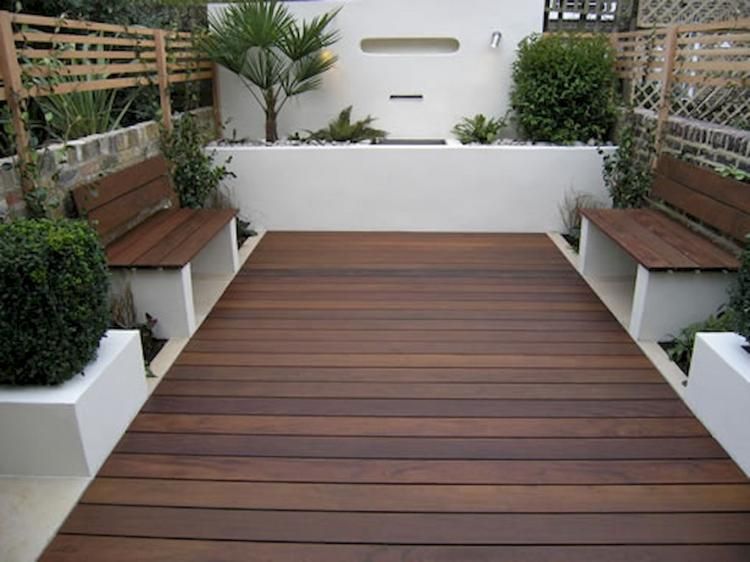 Paint the deck in a color that repeats that of exterior door frames. In this backyard it’s the rich shade of the double doors that lead from the interior to the garden, but with a fabulous range of different deck paint colors on offer, it’s also easy to match door or window frames in blues, greens, grays and more.
Paint the deck in a color that repeats that of exterior door frames. In this backyard it’s the rich shade of the double doors that lead from the interior to the garden, but with a fabulous range of different deck paint colors on offer, it’s also easy to match door or window frames in blues, greens, grays and more.
(Image credit: Sadolin)
If you want to give a rustic backyard a modern edge, paint your deck black. The shade will look striking alongside softer hues that you might more typically find in a country plot such as creams, greens and blues. A color like this one needs to be kept perfectly crisp so bank on repainting your deck more frequently than you might with other paint shades to maintain it.
18. Take a contemporary approach
(Image credit: Simon Orchard Garden Design)
If you want to create a contemporary scheme, gray could prove the best color for a deck. ‘If the house windows or bi-fold doors are anthracite gray using gray for the decking helps to tie the whole scheme together and unify garden and house,’ says Simon Orchard of Simon Orchard Garden Design , who created this sophisticated garden.
‘In this garden, the decking color is echoed in the seats, firepit and metal frame around the decorative laser-cut screens,’ he explains. ‘The simplicity of this pared-down color palette is very effective in creating a calming space and the dark gray creates a fantastic foil for the more colourful planting.’
What is the best color for a deck?
The best color for a deck is one that fits your garden’s style – be that contemporary or more classic – works with the rest of its hardscaping, as well as the planting, and is sympathetic to the house, too. But that actually gives you a wide choice, which can feel a bit overwhelming.
If that’s the case check out our ‘How do I pick a deck color?’ section, below, for ways to approach the dilemma.
How do I pick a deck color?
You can pick a deck color in a variety of ways. ‘We’re taking more of our cues from the natural world, so choosing a color that reflects the style and tones in your garden is a great starting point,’ says Jimmy Englezos, Ronseal Decking Expert and Senior Product Manager.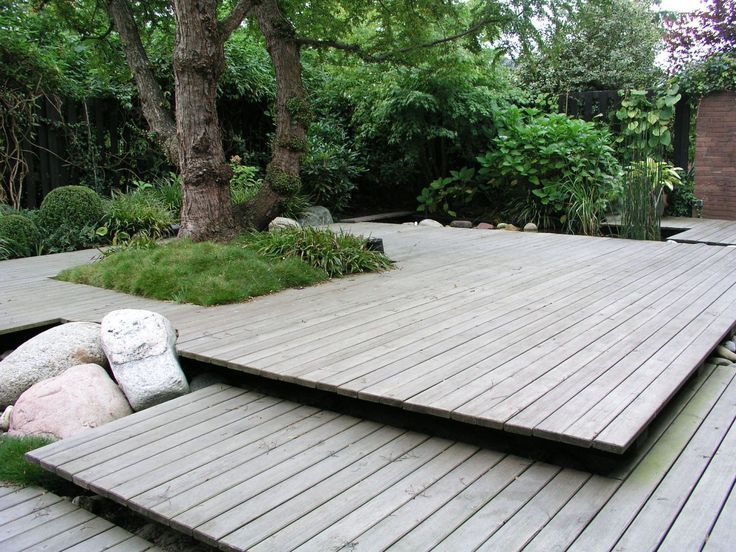
‘Consider a shade that matches border or other plants – or co-ordinates with garden furniture, fences or sheds.
‘Bold shades are everywhere this year, and choosing rich or darker shades will provide a great showcase for green foliage and complement flowers and shrubs, providing an outdoor oasis feel.
‘If your space is smaller, opt for a lighter or even a white color scheme, used across decking, sheds, furniture, walls and even planters to make the most of the room and create a fresh, stand-out, summer look.’
Should house and deck be the same color?
A house and deck can be the same color, but they don’t have to be. ‘If you're after a matching look, the exterior of your house should ideally have some timber elements in order for the decking to look like a cohesive part of your home,’ says Matthew Brown, Sadolin Technical Consultant. ‘These features could be as large as timber cladding or as subtle as a few exposed beams, a wooden porch or a wooden balcony.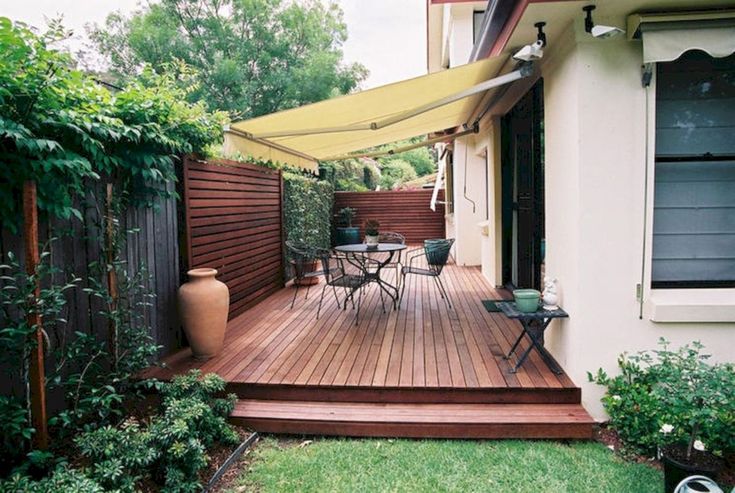 The tone of wood of these outdoor elements will help guide your choice of paint or stain when treating your decking.’
The tone of wood of these outdoor elements will help guide your choice of paint or stain when treating your decking.’
But a deck can be a different color to the house. ‘Let the elements surrounding the decking influence the choice of color you make,’ suggests Matthew. ‘For example, a mostly green area might inspire you to choose a natural palette of greens and muted browns.’
Or, if the deck connects directly with the house, other elements could be the starting point. ‘Why not choose the same color used for the front door or the window frames or, alternatively, opt for a color that’s similar to the shade of your house exterior,’ says Matthew.
Sarah is a freelance journalist and editor. Previously executive editor of Ideal Home, she’s specialized in interiors, property and gardens for over 20 years, and covers interior design, house design, gardens, and cleaning and organizing a home for H&G. She’s written for websites, including Houzz, Channel 4’s flagship website, 4Homes, and Future’s T3; national newspapers, including The Guardian; and magazines including Future’s Country Homes & Interiors, Homebuilding & Renovating, Period Living, and Style at Home, as well as House Beautiful, Good Homes, Grand Designs, Homes & Antiques, LandLove and The English Home among others.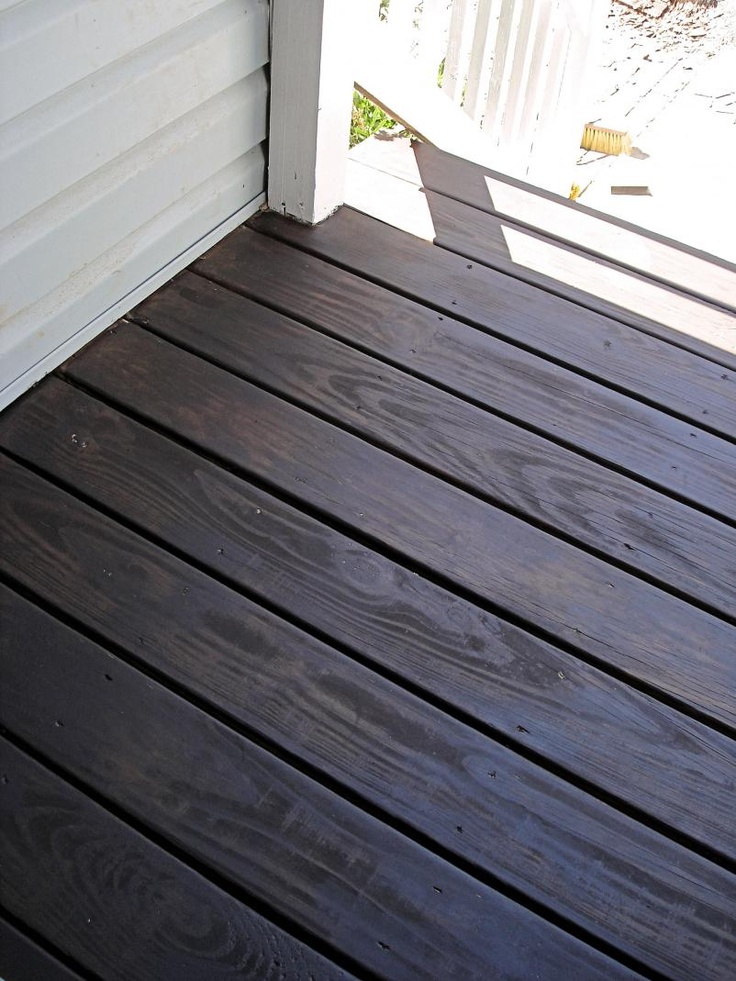 It’s no big surprise that she likes to put what she writes about into practice, and is a serial house renovator.
It’s no big surprise that she likes to put what she writes about into practice, and is a serial house renovator.
Decking color ideas: 11 stylish shades
(Image credit: Millboard/Ben Powney Hythe Garden Landscapes)
Choosing between decking color ideas is an important decision when installing this fabulous garden feature. Whether natural, bold, or modern monochrome, your tone of choice can help make or break your stylistic vision for the space.
Perhaps you're choosing a new composite design and are deciding between various shades on offer – these days, there are plenty to choose from, after all. Or maybe, you are planning on giving existing timber decking a spruce with a fresh lick of wood stain or exterior paint.
Either way, we've brought together lots of different looks to get you inspired, to help you pick the best color to not only complement your other decking ideas but also your wider garden.
11 dazzling decking color ideas for on-trend backyards
From soft sage to bright white, we’ve rounded up some of our favorite schemes for decking color ideas.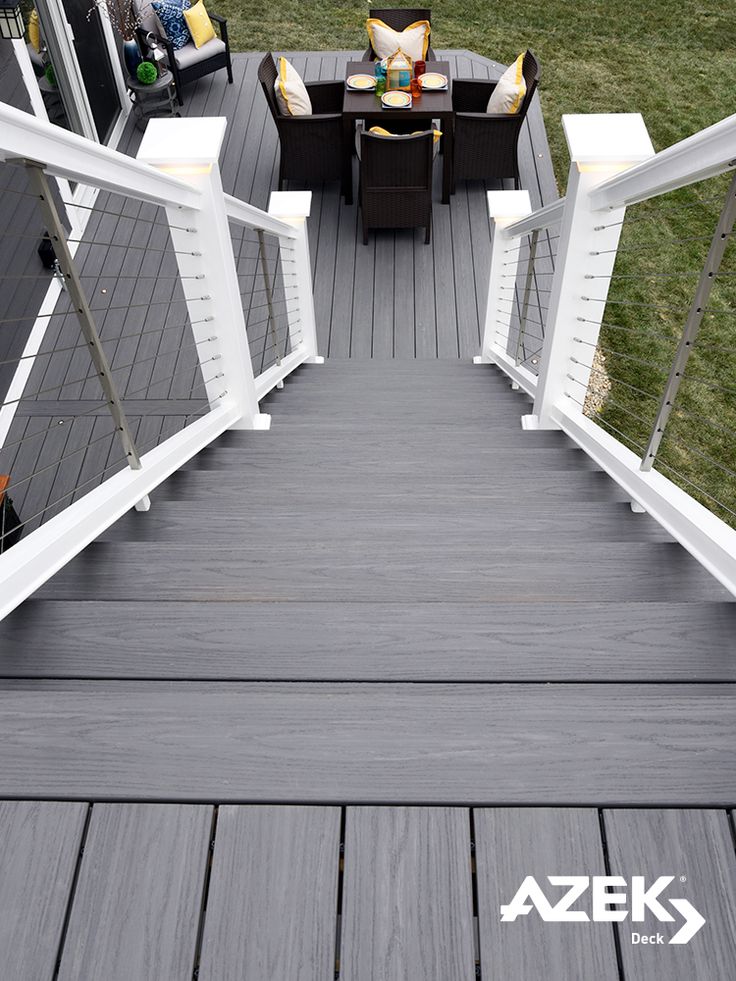
1. Chic stripes
Add character to your paths
(Image credit: Mabo/Alamy Stock Photo)
Go bold and make a style statement with your decking color ideas by combining contrasting hues to make stripes.
Here, the black stripes alongside natural timber hues add a playful element that works well with the surroundings without being overbearing. It's a great way to add extra personality to a path, and of course, you could mix up the colors to suit. A soft blue and white stripe, for instance, would work well for an oceanside theme.
2. Soft green
Go for a sophisticated scheme with green
(Image credit: Rusana Krasteva/Alamy Stock Photo)
If you don't want anything too showy, a gentle shade of sage green is always a good choice for adding character and laid-back charm to decking. What's more, it will blend effortlessly with surrounding foliage and potted plants, as demonstrated here.
Consider painting nearby decking railings or fences in a crisp white, which looks especially lovely alongside this tone.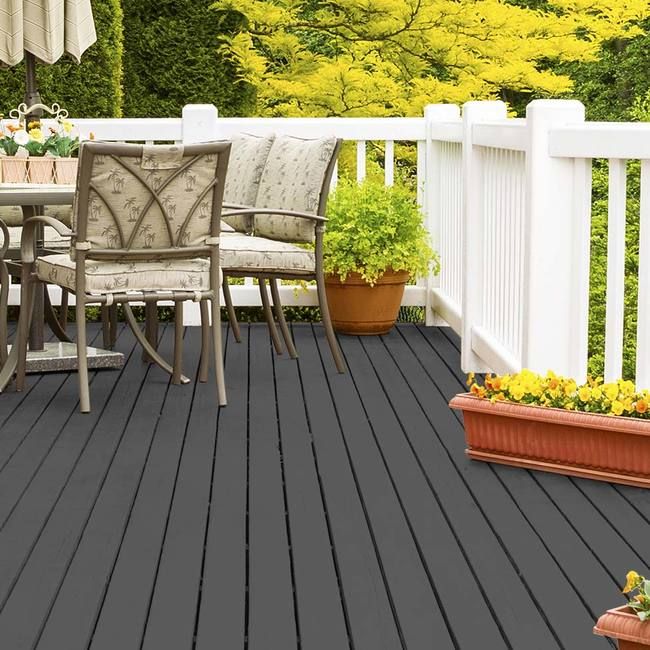 We particularly like the rope detail on this divider, too. Alongside the striped sun chairs, it offers a subtly nautical nod.
We particularly like the rope detail on this divider, too. Alongside the striped sun chairs, it offers a subtly nautical nod.
3. Brushed balsalt
Millboard's 'Brushed Basalt' composite decking looks stunning in this space
(Image credit: Millboard/Ben Powney Hythe Garden Landscapes)
A dusky gray is a gorgeous decking color for more contemporary schemes. And in our opinion, it will never go out of style.
In a natural wood-grain finish (whether that's real timber or composite), it's an elegant choice for garden paths and seating areas lined with sculptural grasses and ferns. The result: a sophisticated, modern space with a jungle-like twist.
4. Golden oak
The 'Golden Oak' enhanced grain composite decking from Millboard sets a contemporary tone for this zone
(Image credit: Millboard)
Warm up the vibe of your seating space by opting for a gloriously golden hue in a smooth timber finish.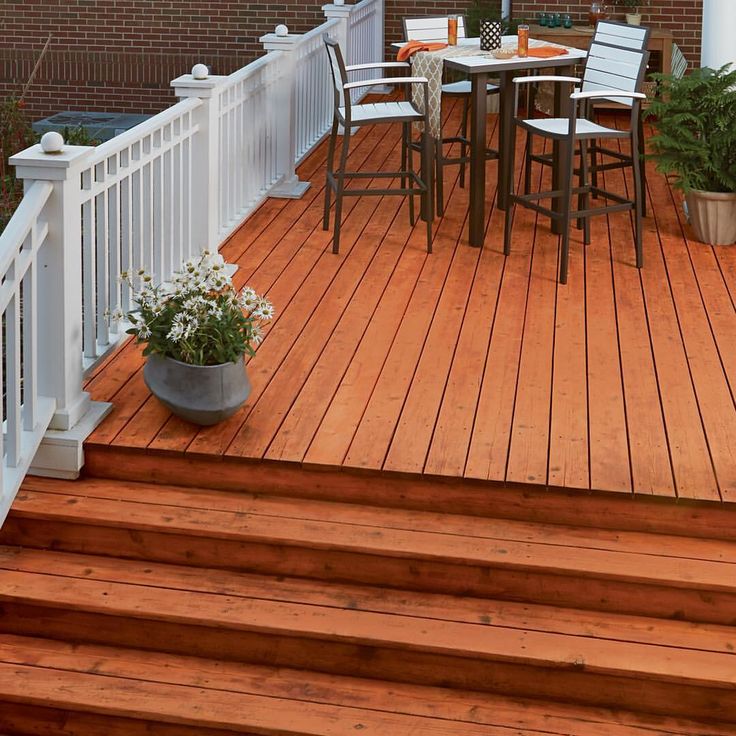
You could even extend the look beyond the floor to built-in benches and planters for a cohesive and contemporary aesthetic. Pick a minimal color palette for your flowers and foliage to maintain the considered feel – purple nepeta will look lovely against the gold tones.
And to give your space some extra sparkle when night falls, invest in some clever deck lighting ideas – these subtle strip lights provide a welcome glow.
5. Charcoal black
Dark and moody-hued decking always looks stylish
(Image credit: mike jarman/Alamy Stock Photo)
For decking that oozes a sense of industrial-chic, opt for an inky charcoal tone. It makes the perfect backdrop for contemporary furniture – think warm coppers, pale rattan, or even bright and bold colorful garden furniture ideas. Plus, it'll make any nearby planting pop. Add a patterned outdoor rug for extra style points.
And, it will stay looking good for longer, as the dark hue will help disguise grubby marks that will inevitably occur over time. And when it is time to give it a spruce, our guide on how to clean decking is worth a peruse for plenty of useful tips.
And when it is time to give it a spruce, our guide on how to clean decking is worth a peruse for plenty of useful tips.
6. Trendy two-tone
These steps are built with Enhanced Grain 'Smoked Oak' decking and 'Brushed Basalt' bullnose board – both from Millboard
(Image credit: Millboard)
'Consider choosing an alternating edging piece to signify a step or add interest to your deck,' suggests the team at Millboard . Not only is it aesthetically pleasing, but it's practical, too: 'Highlighting the edges of steps or drops from the side of decking can reduce the risk of visitors misstepping or losing balance.' It's a stylish solution if you're on the lookout for new garden steps ideas.
Alternatively, introduce a second, complementary tone with timber-effect planters, benches, or tabletops – an effective way to break up a space that may otherwise heavily feature one color.
7. Bright white
Lighten up your space
(Image credit: A Garden/Alamy Stock Photo)
Painting a small deck in a dazzling white will make your seating space instantly feel bigger and brighter as it bounces the light around.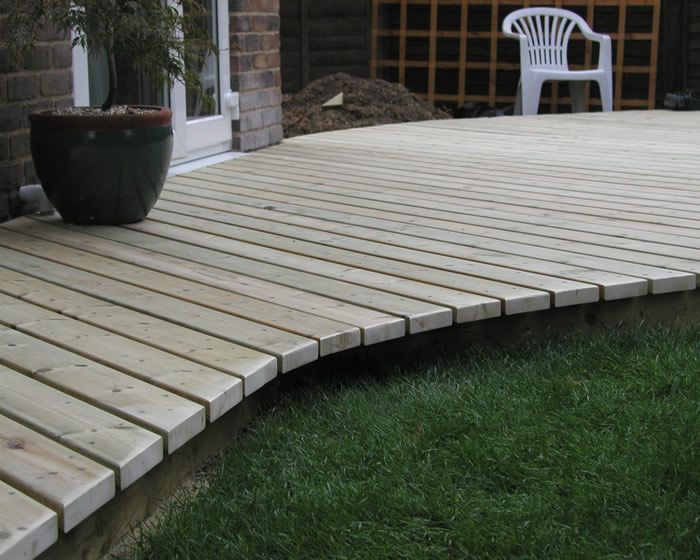 Ideal for lifting a shadier spot, it'll provide a Scandi-chic backdrop for both bold-colored furniture and neutral shades alike, depending on your preferred theme.
Ideal for lifting a shadier spot, it'll provide a Scandi-chic backdrop for both bold-colored furniture and neutral shades alike, depending on your preferred theme.
We love how the honeycomb-shaped wall fitting has been painted to match in this setup, to extend the look. Why not plant some white flowers in containers, too?
8. Stylish stencils
Get creative with a painted design
(Image credit: Future)
Another way to channel personality into your decked space is to get creative with stencils and a duo of complementary colors. Or, if you’re handy with the paintbrush, you could even paint your own design freehand.
This gray and white combo makes a subtle yet stylish statement and looks right at home with the eclectic surroundings. A great option if you’re a fan of bohemian garden ideas.
9. Rustic timber
Weathered Oak composite decking in 'Vintage' from Millboard looks stunning around a pool
(Image credit: Millboard)
Sometimes, natural is best, and this gorgeous timber-effect decking is a case in point.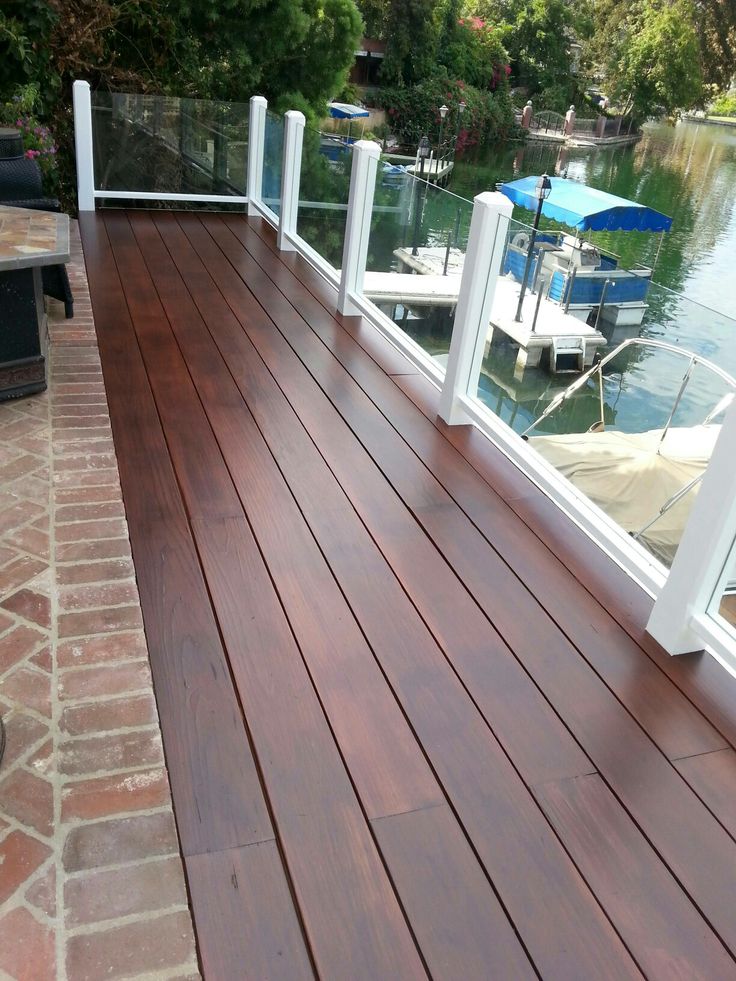
It gives the scene a wonderfully organic charm. And due to its non-slip finish, it's the perfect surrounding for a pool. Plus, it looks fabulous against the contrasting blue tiles.
You can find lots more stylish pool deck ideas in our dedicated feature.
10. Pale driftwood
The Weathered Oak 'Driftwood' boards from Millboard have tons of rustic appeal
(Image credit: Millboard)
Speaking of rustic charm, this lighter-toned, wood-effect decking is also a real head-turner.
Ideal for a more subtle, contemporary look, it provides an elegant groundcover for a sculptural seating setup, allowing the form of the furniture to take the limelight.
Surrounded by neatly-clipped topiary balls, the resulting scene is simply stunning – and ideal for a modern garden.
11. Bold red
Make a bold impression with your walkways
(Image credit: Ros Drinkwater/Alamy Stock Photo)
A vibrant red might not be quite right for your entire decked space, but if you're looking to create a statement walkway, why not go big and bold and embrace the hue?
It'll give your garden an instantly artsy feel, especially if you line it with lots of architectural planting. Pair with a quirky garden building, a colorful bench, and other contemporary features, just like in this scene, for a lasting impression.
Pair with a quirky garden building, a colorful bench, and other contemporary features, just like in this scene, for a lasting impression.
Of course, if red isn't your vibe, you could opt for a different color instead – maybe ochre yellow, hot pink, or deep blue. Our guide to garden color schemes has plenty of tips to help you choose the hues for you.
How should you choose the best color for your decking?
There are multiple ways to go about picking the best color for your deck. First, 'think about where your deck will be laid,' says the Millboard team. 'If you're going for a deck that sits against your house, what is the color and texture of your wall covering? Whether it is brick, render, or cladding, the trick here is to choose a shade that complements your existing scheme, rather than one that is either too similar or jars against it. Also, consider the color of your window frames and interior style to ensure a cohesive look.'
Think about the surrounding hard materials in the area, too, to complement or contrast with them – this could be your garden fencing, a shed, or an outbuilding.
You can also use decking color ideas to get creative. 'Use two or more colors to zone an area,' suggests Millboard. 'Think about how your decking will be used; one side could be a formal area set up with a table and chairs for alfresco dining, the other a place to relax with an outdoor sofa, rugs, blankets, and festoon lights.' A strip of decking in a contrasting color can help define the spaces.
'Alternatively, visually separate the two by choosing a conjoining deck in two different colors to provide a clear contrast,' the team continues. 'This would work well for a space which has two very different uses, such as an outdoor kitchen and bar area coupled with a separate dining area.'
The garden was always a big part of Holly's life growing up, as was the surrounding New Forest where she lived. Her appreciation for the great outdoors has only grown since then. She's been an allotment keeper, a professional gardener, and a botanical illustrator – plants are her passion.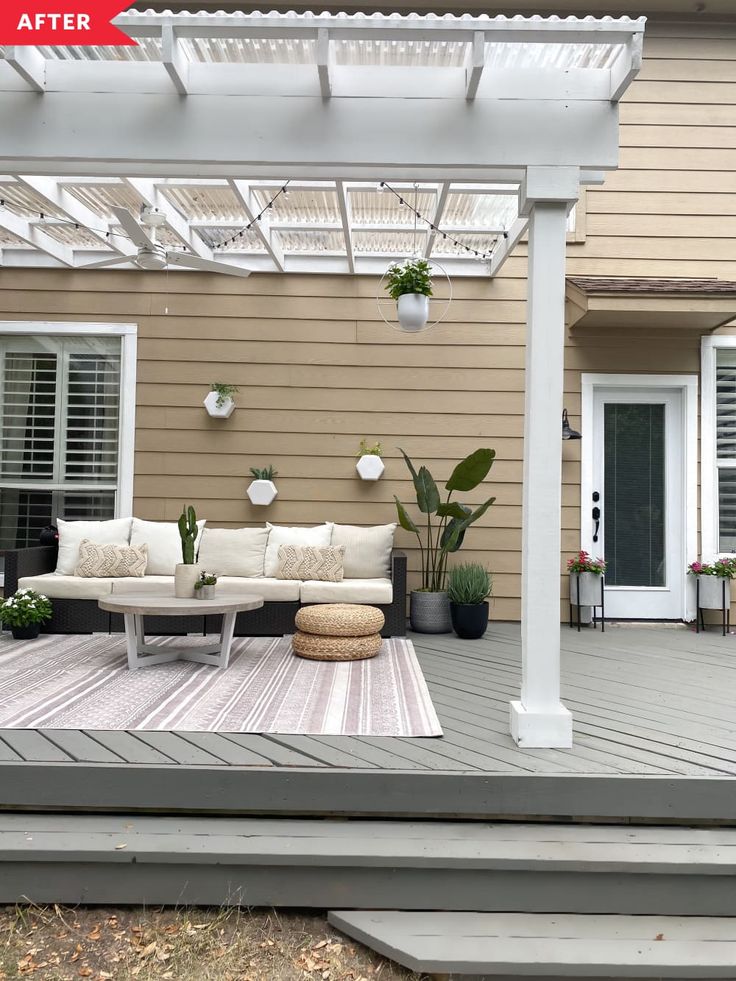
Do-it-yourself garden wooden flooring in the dacha
If the dacha does not have a terrace, this is no reason to deny yourself summer tea parties in the fresh air. Garden wooden decking - simple, light, mobile - is no less functional and reflects the atmosphere of the times.
RD Interiors
gnulidugi
What is garden decking?
Usually a solid or modular platform made of wood or composite materials. Wooden decking creates a solid base that is essential for placing large outdoor furniture. But, unlike the terrace, which is located on an elevation above the ground, the flooring is laid directly on the soil and is separated from it only by the thickness of the shield (and it can be minimal).
Chicago Specialty Gardens, Inc.
Easier is better
The simplest design is perhaps the main advantage of wood flooring.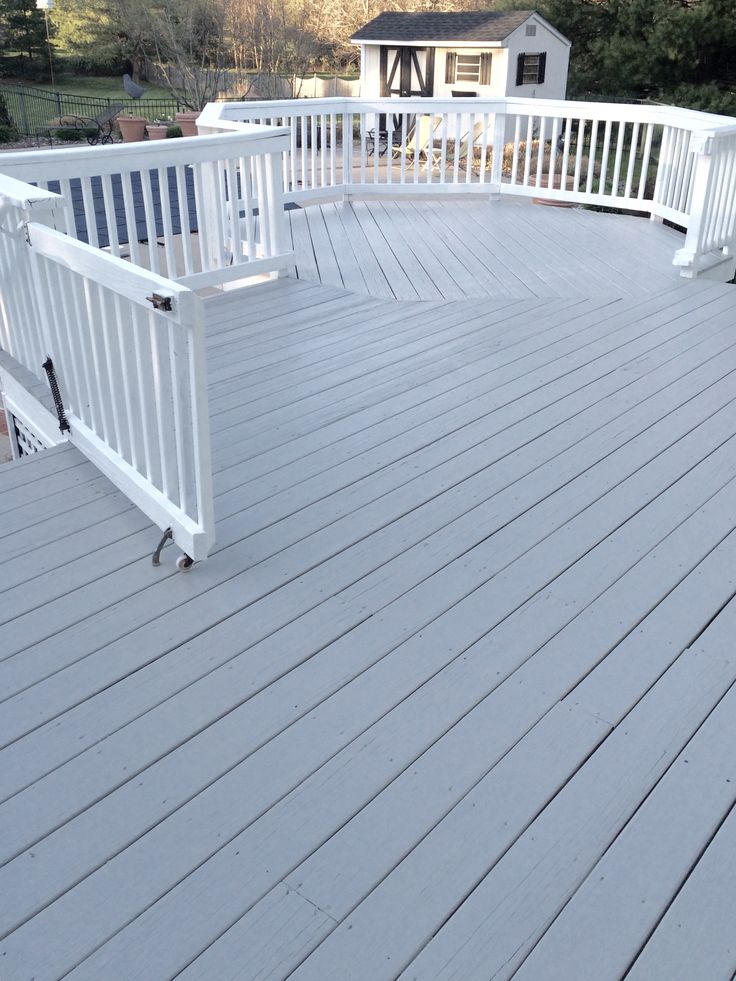 An even solid base is required - if there is such a site with good drainage, you can lay the flooring simply on the surface of the soil. If there is no flat area, or you are planning to lay a large area, it is worth making a traditional prepared base: a sand or sand and gravel cushion.
An even solid base is required - if there is such a site with good drainage, you can lay the flooring simply on the surface of the soil. If there is no flat area, or you are planning to lay a large area, it is worth making a traditional prepared base: a sand or sand and gravel cushion.
Tip: The gravel backfill is both a drainage function and a decorative feature, protruding along the perimeter of the deck. Just need to provide a place for water flow.
Natalia Borisova
Flooring arrangements will depend on what material and structure of the flooring you choose.
1. Plank garden deck
This is the most permanent type of wood deck (although it can be moved if necessary). The flooring involves the construction of a wooden covering on logs with various laying options. For such a flooring, a frame is made of timber with lags in the shape of the planned site. With a large area or a complex laying pattern (diagonal, combined), the logs are installed in two layers.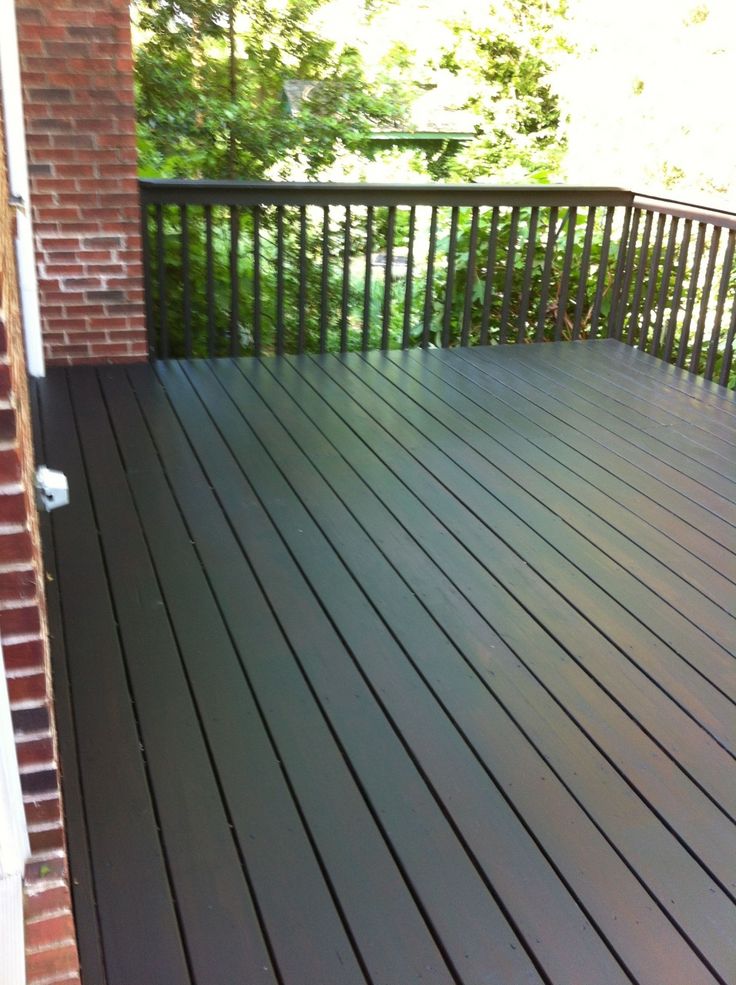
Boxleaf Design, Inc.
The further process is similar to laying interior flooring - even the laying patterns can be used the same as for parquet boards. Such flooring will slightly raise the platform above the ground (by the thickness of the base beam). But this has its plus - the coating will be warmer and better ventilated.
Idea: To make the flooring more mobile, you can make separate modules in this way and assemble the flooring by fastening them together.
Artecology
Weatherproof wood or decking is the best material for wooden decking, but the cost of such construction will be higher. The service life of simpler varieties will be extended by additional processing of wood - for a durable structure, this is a necessary procedure.
Architectural bureau Designportrait
Wood must be protected from decay with special impregnations and varnishes, the lower part should be well waterproofed, because garden decking is in direct contact with the ground, which means that wood is at particular risk. It is possible to lay a layer of waterproofing material between the ground and the flooring.
Small gaps (3-5 mm) are usually left between the planks for water drainage and ventilation. Of course, stiletto parties will have to be moved elsewhere. But these gaps compensate for the "mobility" of wood in the air - its swelling and drying.
Greenblott Design
2. Finished modular flooring
This flooring is called "garden parquet" because of its similarity to panel parquet. It is sold in the form of square plates with locks of various types, which allow you to fasten them together, creating a single canvas - just like in the interior, except that the locks are usually different. The modules themselves already have a certain pattern for the location of the dies - straight, checkerboard and even diagonal. Due to the different arrangement of elements during the assembly of the flooring and their combination, it is possible to achieve a different pattern of the finished canvas. Such flooring is easy to find on sale.
Such flooring is easy to find on sale.
The Land Collaborative
The most common modules are blocks made of natural wood, plastic or a composite material based on wood flour and binders, fixed on a plastic base. Another option for prefabricated garden decking can be polymer modules - the same ones used for sports and playgrounds. They often have a mesh structure, which also contributes to the flow of water. A separate plus of ready-made modules is that their surface is most often non-slip due to the properties of the material or a specially applied texture. The small size of the modules (often - 30x30 cm) allows you to flexibly vary the size and shape of the flooring. Thanks to this, they are also convenient to use for decorating passages between beds and paths in the garden. Platforms and passages made of similar material will give the garden neatness, and the landscape - unity.
Form Collective
Modular garden parquet can also be assembled directly on the ground.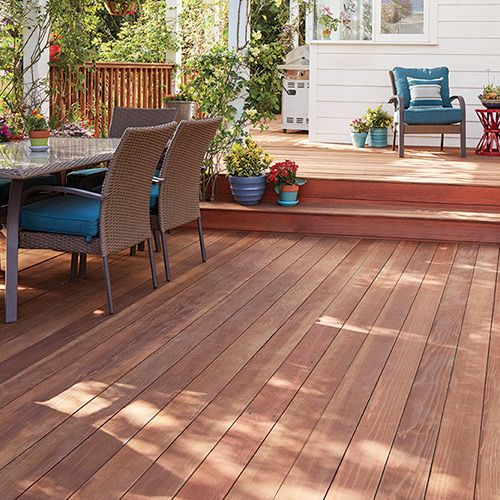 But due to the small thickness of the modules, a flat base is especially important for its installation. It must be well tamped and additionally can be covered with geotextiles.
But due to the small thickness of the modules, a flat base is especially important for its installation. It must be well tamped and additionally can be covered with geotextiles.
austin outdoor design
3. For those who like to recycle - from pallets
You can argue about the applicability of storage pallets in design, but if you do use them, garden decking is one of the best applications. They are wooden (sometimes immediately with special impregnation from decay) and plastic. And in their form they are a ready-made base for flooring. But there is one caveat in their use in this way: pallets, as a rule, have wide gaps between the boards, so they will have to be supplemented with a top coating - for example, moisture-resistant plywood. In addition, you need to carefully consider the strength of the material - if it is untreated pine, it is not very wear and weather resistant. For a longer service, additional processing will be required, and it is better to remove pine pallets for the winter. Due to their modularity, this is not very difficult to do. In fact, pallet garden decking combines the properties of solid wood and modular decking.
Due to their modularity, this is not very difficult to do. In fact, pallet garden decking combines the properties of solid wood and modular decking.
Green Studio
There are only a few restrictions on the use of garden decking. The site must be flat or terraced. The boardwalk can also be laid on a plane with a slight slope, compensating for the angle with the thickness of the beam, but this is already a complication of the design and an obstacle to mobility. In addition, good drainage is needed, and the base must be strong enough. That is, in some cases, it may require special preparation. But the advantages of flooring can be called a lot.
Ellie Lillstrom Photography
Simplicity and speed
The terrace is a permanent building. Its construction requires a large amount of construction work and careful planning. With flooring, everything is simpler, it does not require a foundation or penetration into the ground.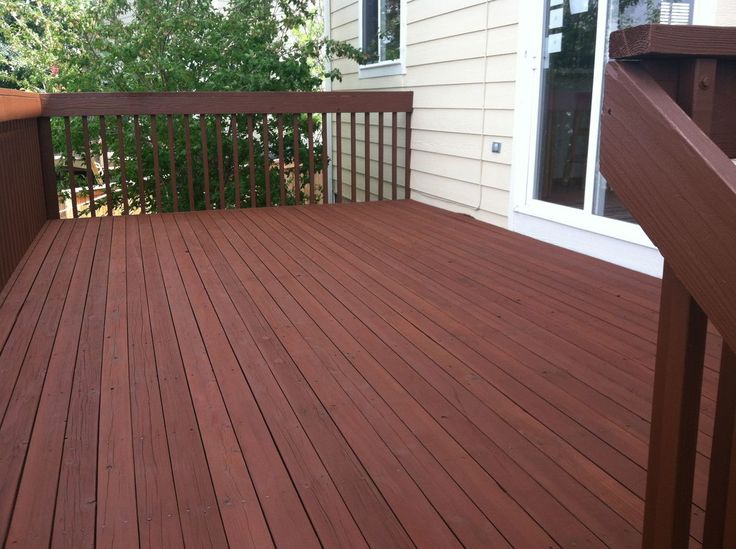 You probably won't need a ladder or even a balustrade. But with the role of a solid platform for placing sun loungers or dining furniture, garden flooring will do just fine.
You probably won't need a ladder or even a balustrade. But with the role of a solid platform for placing sun loungers or dining furniture, garden flooring will do just fine.
SEE ALSO…
10 Simple Outdoor Living Room Design Tricks
Effect Home Builders Ltd.
The decking is quick and easy to assemble, especially if prefabricated elements are used. But even if you decide to do it from scratch with your own hands, it will not require too complex building skills from you. That is why garden decking is ideal for new or neglected areas - you will quickly create a solid platform on a flat open plane or in an old garden, near a house or "temporary hut".
Bergen Street Studio for Architecture
Depending on your future plans, flooring can be considered as a temporary option. Although this is just the case that will surely become a positive confirmation of the well-known saying.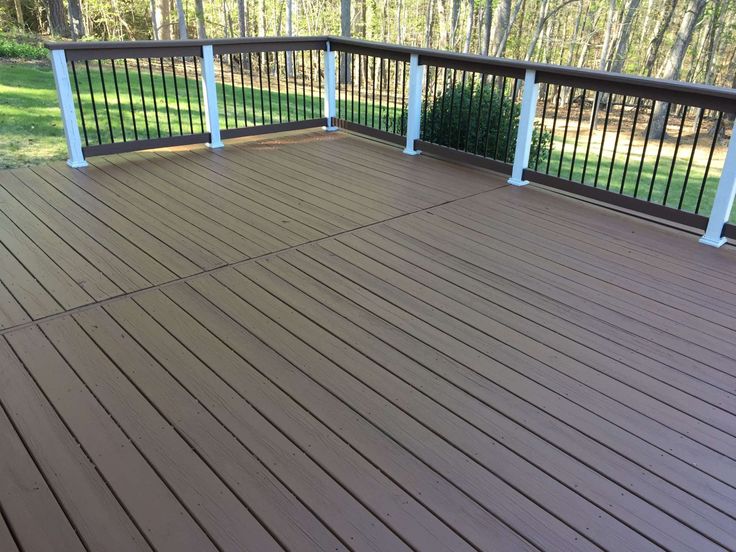 There will simply be no reason to replace the flooring with something more capital, for all its merits.
There will simply be no reason to replace the flooring with something more capital, for all its merits.
And by the way, garden decking can replace not only the terrace: it will be an excellent alternative to paving. More simple and cheaper than porcelain stoneware, and even more so - natural stone. And more mobile.
Yorkshire Garden Designer
Mobility and flexibility
Mobility is one of the main advantages of garden decking. This is not a capital structure with a foundation and deepening. Even in its most stationary version - in the form of a solid platform - the flooring simply lies on the ground. Modular garden parquet is generally easy to disassemble. This means that the layout of the site becomes flexible - a great option for irrationals and those who like to change everything around. A dining or relaxation zone every season (or even much more often) can be arranged in a new place. In front of the house, by the pond, in the depths of the garden - where do you dine today?
Maaike van Diemen interieurontwerp
In addition, the simplicity and modularity of the design allows it to be stored away for the cold season.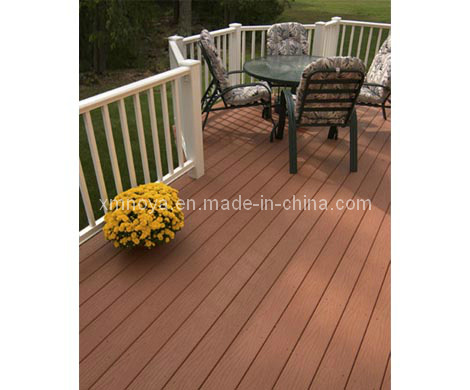 This will protect the material from aggressive environments and extend its service life.
This will protect the material from aggressive environments and extend its service life.
Idea: With modular decking, it's easy to create a temporary space for an outdoor summer party, and after it's over, the area can be dismantled and stored away.
SEE ALSO…
20 ideas for carefree outdoor summer parties
Clinton & Associates, PC Landscape Architects
Outdoor Zoning
Flooring, like paving, is a good way to zone a site. It clearly outlines the boundaries of the site, allocates space from the surrounding landscape. The terrace usually adjoins the house and marks a gradual transition from the interior space to the exterior. The flooring has no architectural binding - it can be placed anywhere in the garden. And unlike the terrace, it denotes the shape of the site directly on the ground, or with a very slight rise. That is, zoning retains maximum openness, the space is less fragmented.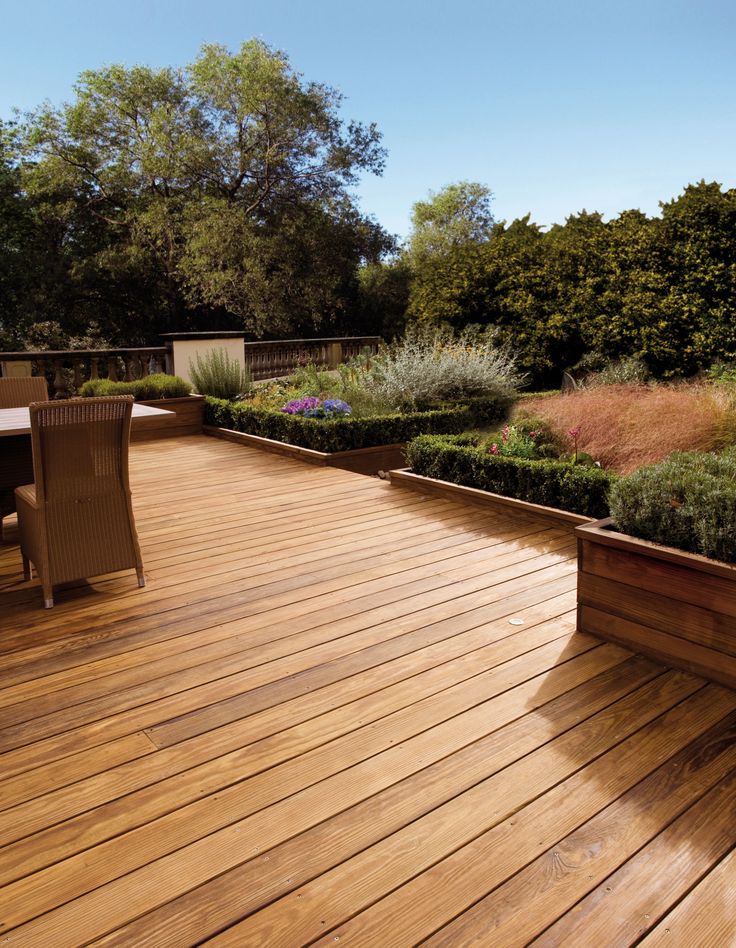 From the environment, the flooring stands out only in material and color, but not in height.
From the environment, the flooring stands out only in material and color, but not in height.
SEE ALSO…
Break Through the Barriers: 11 Techniques for No-Fence Zoning
TC Williams, LLC
Decorative Options
design solution. You can vary its color, shape, material, styling pattern.
1. It is not necessary to make the decking rectangular. The material, of course, imposes its limitations, but with self-production it is quite possible to make even rounded lines, although this will require more work.
Arteza Company
2. You can emphasize the geometry and make the flooring polygonal, or use a scalloped edge that will create an interesting transition to the surrounding space. It is especially easy to leave such a "torn" edge when laying modular garden parquet.
3. The lightness of the design allows you to leave holes in the flooring - to bypass existing trees, fit in a mini-pond or flower garden.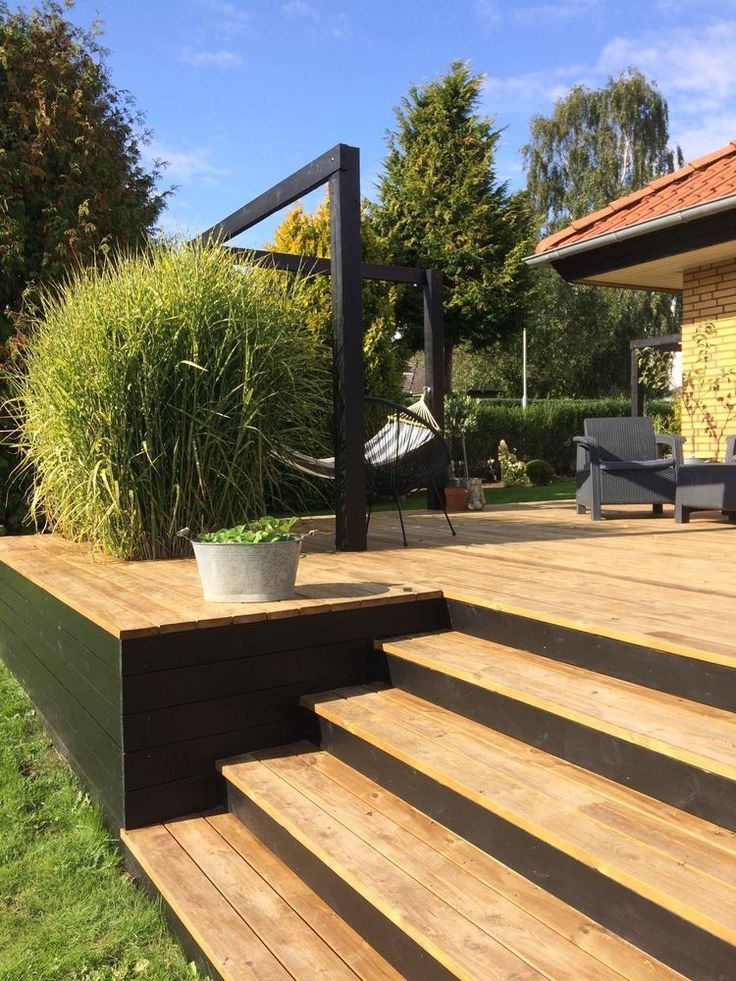 By the way, plants in flower pots look great on the flooring itself, emphasizing its "parquet", the interior atmosphere taken out into the garden, and also additionally solving zoning problems.
By the way, plants in flower pots look great on the flooring itself, emphasizing its "parquet", the interior atmosphere taken out into the garden, and also additionally solving zoning problems.
Evamix
4. The combination of color and pattern is another spectacular decorative move. Along or across, diagonally or herringbone, checkerboard or zigzag - even if you use one color, the flooring will not be boring. The modularity of the coating simplifies the creation of color combinations.
You can take the paints and apply the design you like: with a stencil or just with a brush. When choosing a paint, keep in mind that you will walk on the flooring - that is, the paint must be wear-resistant.
Sarah Greenman
5. Another decorative move is to combine sections of different heights due to different base thicknesses. In this case, the site is formed as if by wide gentle steps.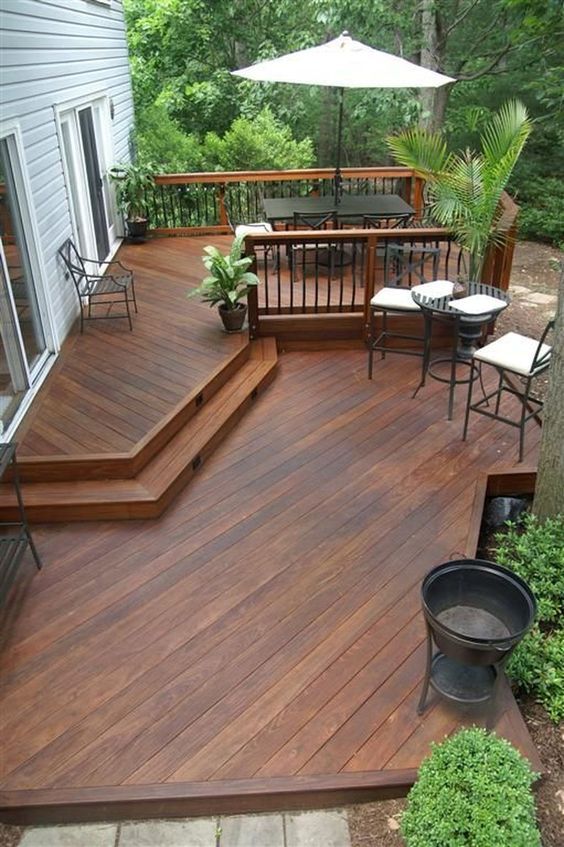 But this is already a way of complication, bringing the flooring closer to the terrace.
But this is already a way of complication, bringing the flooring closer to the terrace.
gnulidugi
Where to use
1. Before entering the house. If there is no porch or it is very small, a garden deck can be a substitute for it. It will take over some of the functions that the porch performs, serve as a buffer zone for dirt and dust. As I mentioned, modular decking can also be used as walkways. In this case, such a path will logically end with a small area in front of the entrance to the house.
SEE ALSO…
Good question: Why does the house need a porch?
NG-STUDIO Interior Design. Sanremo
Holly Marder
2. In front of the house. As a simpler alternative to a terrace for a summer dining or relaxation area. Like a terrace, such a flooring can be supplemented with a canopy, but with a light folding structure.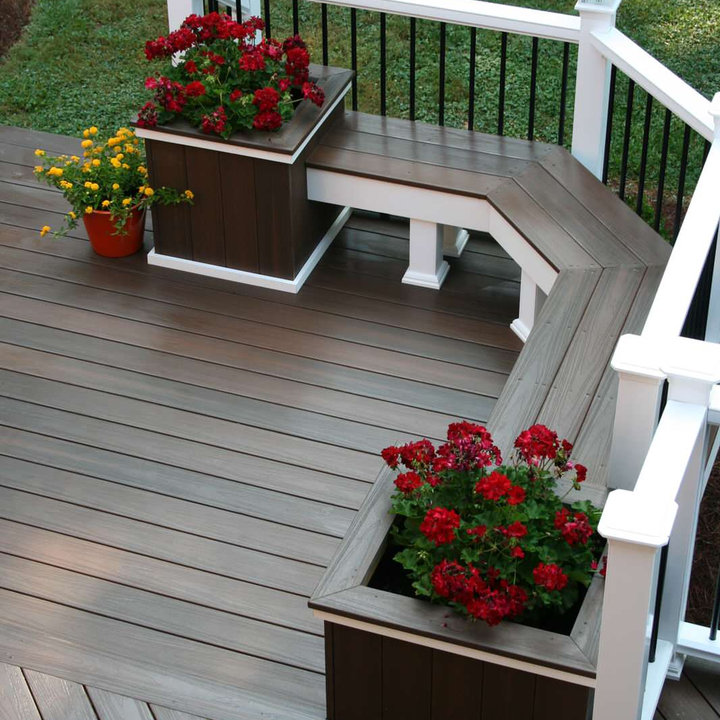 READ ALSO…0087
READ ALSO…0087
3. Courtyard or other walkable areas . That is, where there is a lot of movement and activity in different directions. It is difficult to plan the paths here, and strictly defined directions are inconvenient. Garden decking will create a paved space without major paving.
Architectural Bureau Designportrait
4. Near the pool . A great option for a mobile frame pool. But it will also be good for a stationary buried in the ground: in this case, you can choose more expensive materials, for example, decking. Although one of the advantages of decking is precisely in their simplicity and relative cheapness.
SEE ALSO…
A good question: How to organize a country pool for the weekend
Flooring near the pond will also be useful - it will create a flat area on which you can place a bench or the same sun loungers. Wood - a natural material - will be especially appropriate here.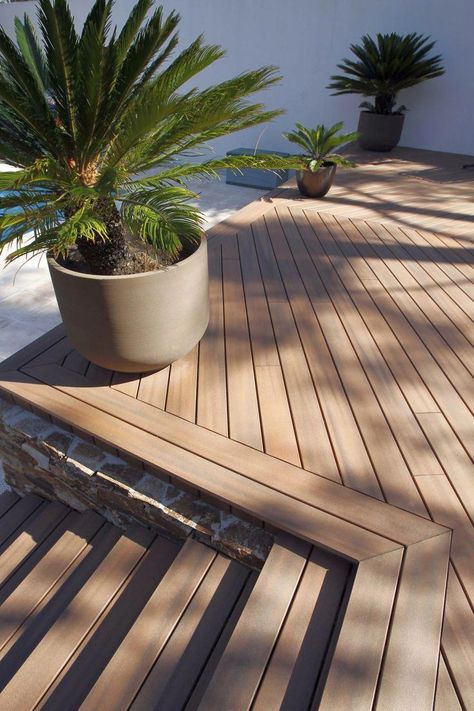 But when placing the flooring near the reservoir, carefully monitor the drainage.
But when placing the flooring near the reservoir, carefully monitor the drainage.
Arbor Group
5. Dining area or seating area in the center of the garden. Here the main advantages of decking are realized - flexibility of form and mobility. It is very convenient to place such a site in an old garden - existing trees are easy to bypass. And the device, using the flooring of a dedicated area for relaxing on the lawn, immediately solves the problem of zoning.
6. Under a pergola or living arbor. Flooring creates a base for it, turning it into a real living pavilion and allowing you to comfortably place furniture.
SEE ALSO…
Living arbor: How to grow it in Central Russia
7. Children's play area. Wood is a great option to arrange a flat playground for children's games. The mobility of the design allows you to build a sandbox and other equipment into it.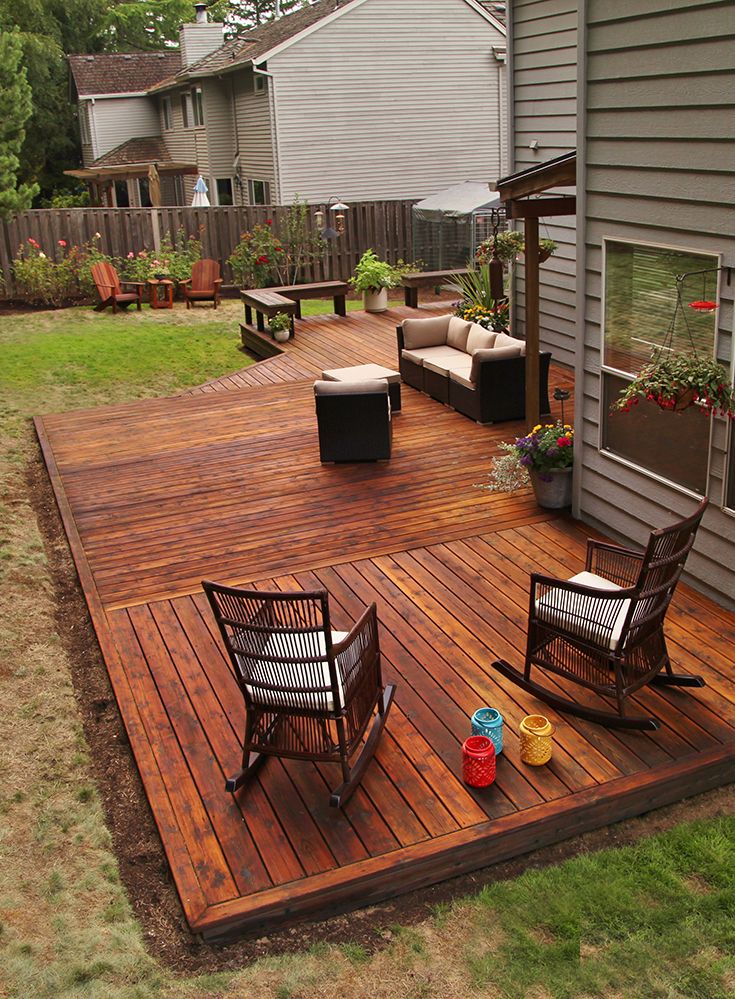
Benjamin Moore
8. Loggias and balconies. Garden parquet is no less useful for city dwellers. It will create on the balcony the atmosphere of a real mini-dacha in an urban environment. Its resistance to atmospheric factors allows you not to be afraid to spill water or spill the earth when caring for your small city garden. And walking on it barefoot is very pleasant.
TELL US IN THE COMMENTS…
What do you prefer: capital or mobility? Have you used modular garden parquet in your garden? Have you tried building your own flooring?
Plank flooring, what is it and how to make wooden flooring yourself
A dacha or a country house without a terrace deprives its owners of outdoor tea parties and other joys of life. This problem can be solved by creating a wooden deck on your own site, which is essentially a modular platform made from lumber or WPC.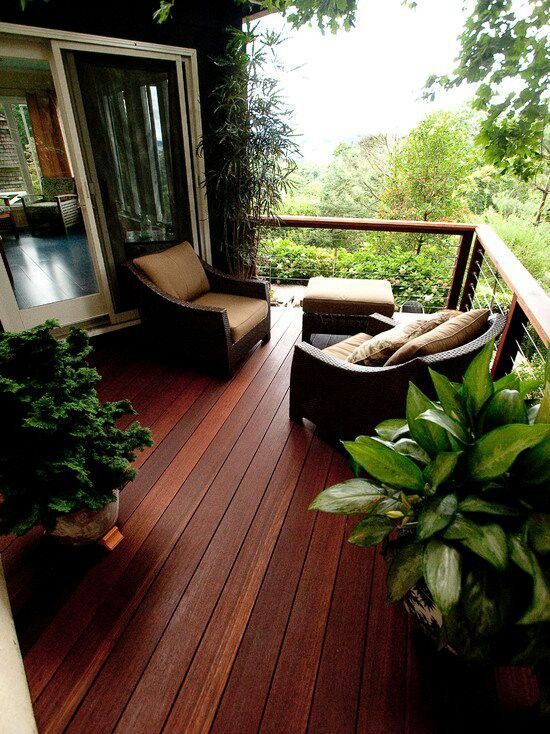 The ultimate goal is to create a strong and solid base on which outdoor furniture or various structures can be installed. What is the difference between a wooden deck and an open terrace? The fact that he settles down right on the ground and can move away from it to a completely insignificant height.
The ultimate goal is to create a strong and solid base on which outdoor furniture or various structures can be installed. What is the difference between a wooden deck and an open terrace? The fact that he settles down right on the ground and can move away from it to a completely insignificant height.
Types of garden decks
The fashion for wooden decking came from the United States and teak wood was used to create them, which was used for arranging ship decks. Open areas serve as terraces, you can sunbathe on them, install various structures that require a solid foundation. For example, it can be an inflatable pool or a simulator. The configuration, shapes and sizes can be any, and sometimes wooden decks are made in the form of a cascade and may have additional elements, such as fences, steps, lighting. Main varieties:
1. Terrace - an area surrounding the house or in front of it. To protect against precipitation and sunlight, it can be equipped with a roof or canopy.
2. Patio. This is a whole zone, which is usually “hidden” behind the house. The patio area is designed for relaxation and it is necessarily completed with garden furniture.
3. Scaffolds - platforms erected around pools or artificial reservoirs.
4. Tracks. You can make one path (from the front door to the gate) or a whole network that “entangles” the site.
Preparation for decking
The procedure for manufacturing the flooring largely depends on what material is planned to be used. The simplest option is wooden flooring, which you can do yourself with minimal experience. Craftsmen even use storage pallets, which have too much distance between the boards. Therefore, to create a flat surface, a suitable floor covering is used. In addition, modular garden parquet is on sale, which can be laid directly on the ground, after preparing the base. But most homeowners believe that WPC decking is the best option, given the characteristics of the material.
Leave a request
for a free calculation
the cost of your project
Calculate the project
It is worth noting that preparatory activities do not begin with the purchase of materials and consumables, and not even with the preparation of the foundation, but with drawing up a plan, which, in fact, is a whole project! A laying scheme is drawn up, on the basis of which the number of decking board units and components is calculated. And when making calculations, the interval between the lags is necessarily taken into account, which depends on the parameters of the board (width, thickness and fullness). Also, the method of installation is determined, on which the choice of fasteners depends.
Site preparation for decking
Laying wooden decks, platforms and other "terraces" directly on the ground is not done if you want the structure to last a long time.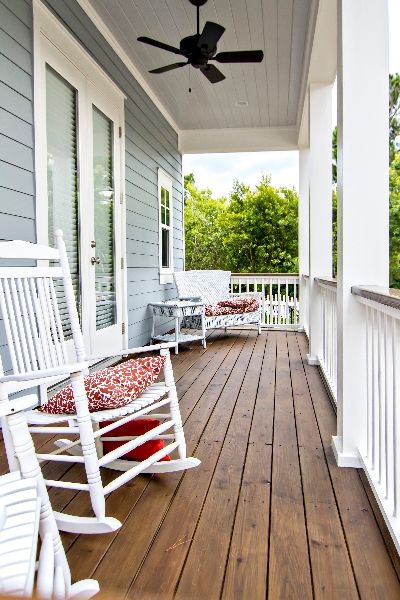 In addition, under it there must be space for air circulation, the flow of melt and rainwater. The function of the base can be performed by asphalt with a slope or a concrete screed. In the absence of a slope, strobes 30 mm wide and 15 mm deep are cut. A sand and gravel cushion in its pure form is also not suitable, so reinforced concrete slabs or metal support beams are laid on top of it. Drainage is a must!
In addition, under it there must be space for air circulation, the flow of melt and rainwater. The function of the base can be performed by asphalt with a slope or a concrete screed. In the absence of a slope, strobes 30 mm wide and 15 mm deep are cut. A sand and gravel cushion in its pure form is also not suitable, so reinforced concrete slabs or metal support beams are laid on top of it. Drainage is a must!
Creation of decking in the country house: basic activities
The device of a wooden flooring is a simple task. To complete it, it is enough to put together a frame from a bar with lags. At the same time, it should have the form of a future site. If a diagonal laying of a wooden board is planned or the flooring will have a solid area, then a two-layer installation of a log is recommended. And further work is carried out by analogy with the laying of interior floor coverings. As a rule, wooden decks are made from planed boards obtained from solid hardwoods (ash, alder, oak).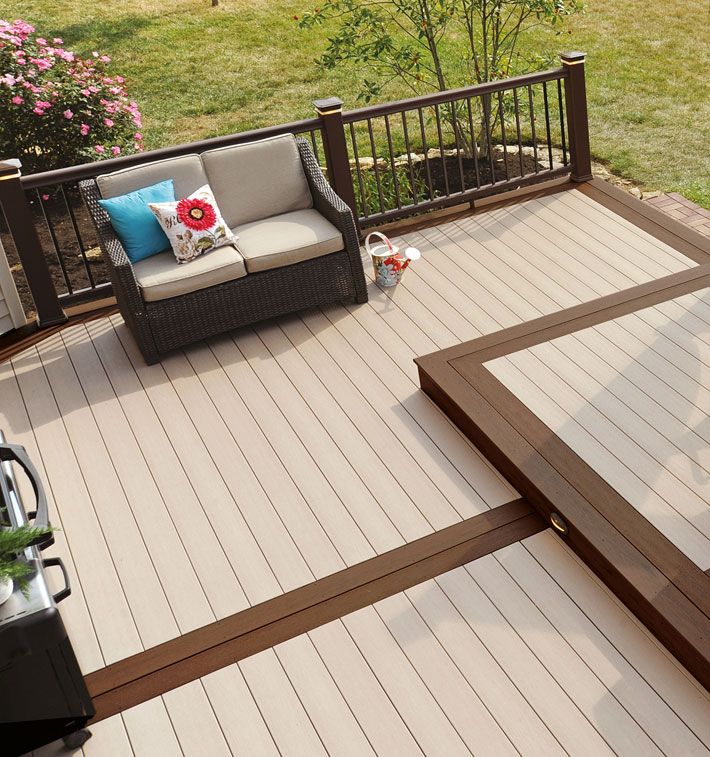 But most often a planed board made of coniferous wood is used. Ideally, it should be larch! The finished site will be raised above the ground, to the height of the timber.
But most often a planed board made of coniferous wood is used. Ideally, it should be larch! The finished site will be raised above the ground, to the height of the timber.
If it is planned to create a flooring from a WPC decking board, then this involves the formation of a supporting frame. All installation work is carried out at positive temperatures. But before proceeding with them, in accordance with a pre-prepared project, you need to assemble an “assembly kit”, which includes the following elements:
1. WPC terrace board purchased in advance and having the desired parameters.
2. Aluminum joists (or WPC), which must be at least 25 mm wide.
3. Corner fasteners (starter bars).
4. End caps (decorative end strips).
5. Finishing profiles and elements to create an expansion gap between planks. The names depend on the manufacturer, since each of them has its own system.
6. Fasteners that are selected based on the method of installation.
Fasteners that are selected based on the method of installation.
Making the support frame is easy. You just need to lay out the beams on the base, on adjustable rigid PVC supports or underlayment, not forgetting the spacing, which must be correctly calculated. Otherwise, the flooring will sag when walking on it. Further, holes are drilled in each beam (every 70 cm), and hardware is screwed into them.
Laying planks
If we are talking about wooden flooring, then it is extremely undesirable to nail the boards, because over time the floorboards will dry out and creak disgustingly, precisely because of the nails. Therefore, self-tapping screws will be the best option. As for the WPC terrace board, its installation can be done by a hidden method, which involves fixing the boards with the participation of the clamps included in the kit. An open mounting method involves the use of self-tapping screws or dowel-nails.